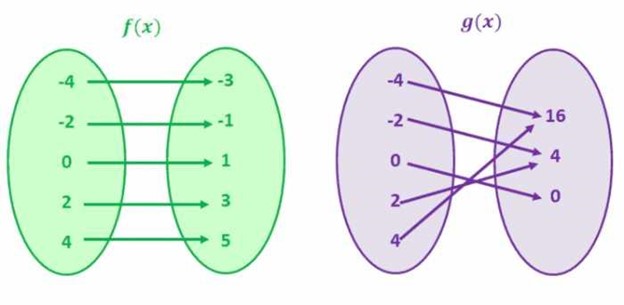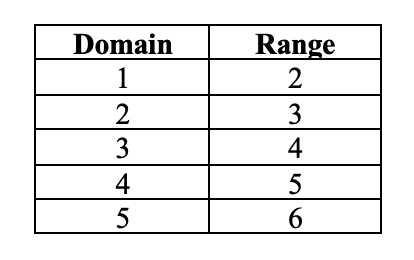One to One Functions - Graph, Examples | Horizontal Line Test
What is a One to One Function?
A one-to-one function is a mathematical function where each input correlates to a single output. In other words, for each x, there is just one y and vice versa. This signifies that the graph of a one-to-one function will never intersect.
The input value in a one-to-one function is noted as the domain of the function, and the output value is the range of the function.
Let's look at the images below:

For f(x), every value in the left circle corresponds to a unique value in the right circle. Similarly, each value on the right side corresponds to a unique value on the left side. In mathematical terms, this implies every domain owns a unique range, and every range holds a unique domain. Therefore, this is an example of a one-to-one function.
Here are some different representations of one-to-one functions:
-
f(x) = x + 1
-
f(x) = 2x
Now let's look at the second example, which displays the values for g(x).
Notice that the inputs in the left circle (domain) do not own unique outputs in the right circle (range). For instance, the inputs -2 and 2 have the same output, that is, 4. Similarly, the inputs -4 and 4 have identical output, i.e., 16. We can comprehend that there are matching Y values for numerous X values. Therefore, this is not a one-to-one function.
Here are additional examples of non one-to-one functions:
-
f(x) = x^2
-
f(x)=(x+2)^2
What are the qualities of One to One Functions?
One-to-one functions have these characteristics:
-
The function has an inverse.
-
The graph of the function is a line that does not intersect itself.
-
The function passes the horizontal line test.
-
The graph of a function and its inverse are equivalent regarding the line y = x.
How to Graph a One to One Function
To graph a one-to-one function, you will have to determine the domain and range for the function. Let's examine an easy representation of a function f(x) = x + 1.

Immediately after you know the domain and the range for the function, you have to plot the domain values on the X-axis and range values on the Y-axis.
How can you evaluate if a Function is One to One?
To test if a function is one-to-one, we can apply the horizontal line test. As soon as you graph the graph of a function, draw horizontal lines over the graph. If a horizontal line passes through the graph of the function at more than one spot, then the function is not one-to-one.
Because the graph of every linear function is a straight line, and a horizontal line will not intersect the graph at more than one spot, we can also deduct all linear functions are one-to-one functions. Remember that we do not use the vertical line test for one-to-one functions.
Let's examine the graph for f(x) = x + 1. As soon as you graph the values for the x-coordinates and y-coordinates, you need to examine if a horizontal line intersects the graph at more than one place. In this instance, the graph does not intersect any horizontal line more than once. This signifies that the function is a one-to-one function.

On the other hand, if the function is not a one-to-one function, it will intersect the same horizontal line multiple times. Let's examine the diagram for the f(y) = y^2. Here are the domain and the range values for the function:

Here is the graph for the function:

In this case, the graph intersects various horizontal lines. For instance, for both domains -1 and 1, the range is 1. In the same manner, for both -2 and 2, the range is 4. This means that f(x) = x^2 is not a one-to-one function.
What is the opposite of a One-to-One Function?
Since a one-to-one function has only one input value for each output value, the inverse of a one-to-one function also happens to be a one-to-one function. The inverse of the function basically reverses the function.
For example, in the event of f(x) = x + 1, we add 1 to each value of x as a means of getting the output, in other words, y. The inverse of this function will subtract 1 from each value of y.
The inverse of the function is denoted as f−1.
What are the characteristics of the inverse of a One to One Function?
The characteristics of an inverse one-to-one function are identical to all other one-to-one functions. This means that the inverse of a one-to-one function will have one domain for every range and pass the horizontal line test.
How do you determine the inverse of a One-to-One Function?
Determining the inverse of a function is not difficult. You simply need to swap the x and y values. For instance, the inverse of the function f(x) = x + 5 is f-1(x) = x - 5.

Considering what we learned earlier, the inverse of a one-to-one function undoes the function. Considering the original output value showed us we needed to add 5 to each input value, the new output value will require us to delete 5 from each input value.
One to One Function Practice Questions
Consider the following functions:
-
f(x) = x + 1
-
f(x) = 2x
-
f(x) = x2
-
f(x) = 3x - 2
-
f(x) = |x|
-
g(x) = 2x + 1
-
h(x) = x/2 - 1
-
j(x) = √x
-
k(x) = (x + 2)/(x - 2)
-
l(x) = 3√x
-
m(x) = 5 - x
For each of these functions:
1. Identify whether or not the function is one-to-one.
2. Plot the function and its inverse.
3. Figure out the inverse of the function numerically.
4. Indicate the domain and range of both the function and its inverse.
5. Employ the inverse to determine the value for x in each calculation.
Grade Potential Can Help You Master You Functions
If you happen to be facing difficulties trying to learn one-to-one functions or similar functions, Grade Potential can set you up with a 1:1 tutor who can support you. Our Huntington math tutors are experienced professionals who assist students just like you improve their understanding of these subjects.
With Grade Potential, you can learn at your individual pace from the comfort of your own home. Schedule a meeting with Grade Potential today by calling (631) 526-7234 to find out more about our educational services. One of our consultants will call you to better ask about your needs to provide you with the best teacher for you!




